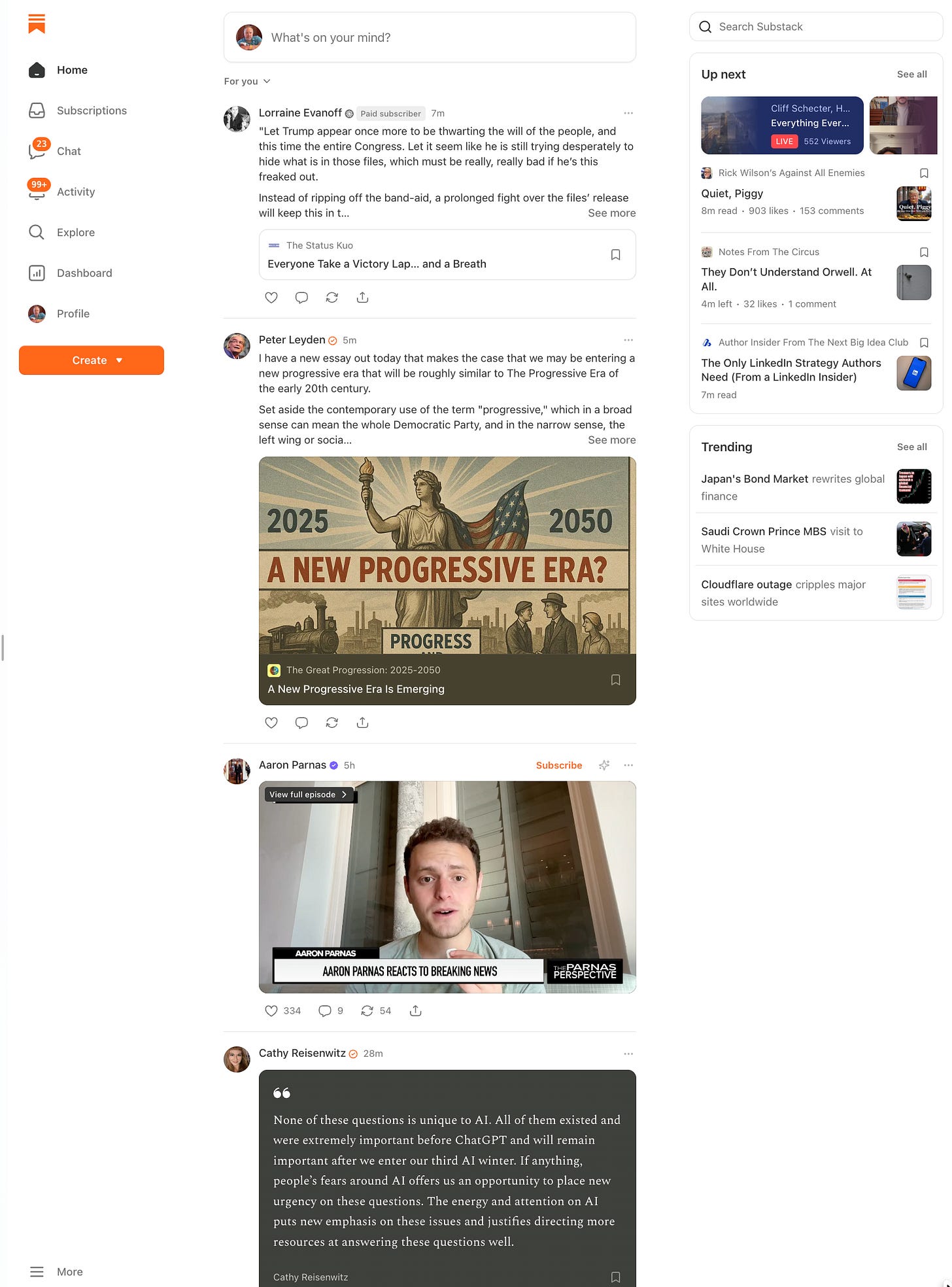Thursday State of the SubStacks: Walking the Tightrope Over the Attention-Economy Abyss
As app‑first feeds and social ephemera threaten the email/blog/tip‑jar core, VC incentives collide with public reason, the brittle economics of “#discoverability” make themselves felt, and it turns out the hard part is the mechanics of the business finding the sweet spot…
Is this thing a serious and sustainable platform business, individual business model, and hence public-reason community?
On the plate we have:
Anne Trubek: On SubStack (sigh) <https://notesfromasmallpress.substack.com/p/on-substack-sigh>: ‘I am not a fan of the… owners…. I expect this platform to become increasingly unfriendly to newsletter writers like me… not chasing Big Scale… [the] Notes (social media-esque) part of Substack. En*tification…. I have tried to leave… and have stalled out, several times, for varying reasons…. Many writers here… making… a substantial portion of [a living]…. is an extraordinary accomplishment and godsend that they have been able to be sustain themselves through newsletters which, like blogs, have been historically well-nigh impossible to profit from…
vs.:
Hamish McKenzie: <https://substack.com/@hamish/note/c-171083114>: ‘Patreon is spending big bucks to lure some Substack writers over to its platform, and some are taking the deal to escape the social features that drive their growth here. (They stay on Instagram, though.) Meanwhile, Patreon is spending that money because it’s trying to spin up the network effects that Substack has by… building social features….
Things we do to help writers who don’t have an existing audience: - Provide a multimedia publishing system that is completely free to use. - Give writers distribution to email, web, and an app, for no cost whatsoever. - Offer an discovery system that includes Notes, recommendations, search, leaderboards, and categories that have the potential to bring you subscribers, completely free of charge. - Publish and provide (free) educational resources that help writers figure out how to best use Substack and make the most of this new model. -Attract writers with large existing audiences to the network so that other writers might convert some of those people into their own subscribers
We have a ton more work to do, and it will never be enough, but we explicitly design Substack to help a new generation of voices emerge. Doesn’t mean that every one will succeed. But here they have a greater shot at building a sustainable media presence and business than anywhere else on the internet…
And:
a. natasha joukovsky: <https://substack.com/@joukovsky/note/c-173537147>: ‘I cannot understand—from a business perspective, mind you—why Substack seems to be prioritizing Notes ephemera over links to longform newsletters. The normal answer here—revenue-maximizing en*tification—simply doesn’t fit on a platform that makes its money through paid subscriptions. Substack’s incentives, as they so often tout, are seemingly aligned to writers’. Gotta wonder if ads are coming soon/what the play here is because the math isn’t mathing…
With a key red flag now appearing to be SubStack Notes <https://substack.com/home> and its associated chonky swol twitter-like feed:
And also on the plate is a note from Mills Baker about what the SubStack team is actually intending SubStack Notes, considered as a social-media feed, to be—a principal channel pushing discoverability:
Mills Baker: Rats from Rocks: ‘no plans for ads at all; there’s a dynamic balance issue with feed tuning that’ll sum to lurching ranking though:
if you want more paid subs, you need more posts served AND more users;
more users come from more engaging feed content (they visit more, stay longer, click on more posts, subscribe more)
we goal on paid subs, so we push posts to the max, but at some point pushing all posts will trade off against post driven subscriptions, weirdly!
eg if feed were all paywalled posts, people wouldn’t come on volume and subscriptions would decline; if it were no paywalled posts, or no posts at all, it would be pointless for us and writers and we’d make no money
it’s just a permanently messy tuning process with dynamic (and ultimately per user) targets…
As I understand it, the key to SubStack’s “Notes” algorithm is that it needs to be one that (i) does not maximize time-on-platform and leaves a bad taste afterwards in the mouths of those who engaged, but (ii) does maximize paid subscriptions to newsletters, and also (iii) leaves readers of “Notes” feeling informed, entertained, and having spent there time learning about interesting things to read.
The “how this works” and how you create this New Model Algorithm remains mysterious to me.
It is a social network, but not: SubStack has an app. Substack spends a lot of its team’s energy and time getting people to download and then use the app. The app is anchored by its feed. But SubStack is trying as hard as it can to hack the brains of those it attract in a different way. Mark Zuckerberg’s team tries to hack your brain so that you spend as much time as possible on-app, so your glued eyeballs can be sold to attention-seeking advertisers. The SubStack team is trying to optimize for the chain: download → view → discover → subscribe → pay. The desired end result for SubStack is a paid subscriber to somebody’s newsletter/ podcast. And there seeking that requires a substantially different feed than the eyeball-gluing maximize time in-app standard social-media feed.
But how, exactly?

